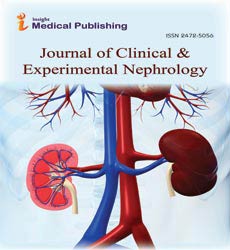Fluid and Electrolyte Disorders: A Critical Challenge in Clinical Practice
Hanish Zhang
Department of Urology, University of Madras, Chennai, India
Published Date: 2024-08-22DOI10.36648/2472-5056.9.4.269
Hanish Zhang*
Department of Urology, University of Madras, Chennai, India
- *Corresponding Author:
- Hanish Zhang
Department of Urology, University of Madras, Chennai,
India,
E-mail: zhang_h@gamil.com
Received date: July 22, 2024, Manuscript No. IPJCEN-24-19691; Editor assigned date: July 25, 2024, PreQC No. IPJCEN-24-19691 (PQ); Reviewed date: August 08, 2024, QC No. IPJCEN-24-19691; Revised date: August 15, 2024, Manuscript No. IPJCEN-24-19691 (R); Published date: August 22, 2024, DOI: 10.36648/2472-5056.9.4.269
Citation: Zhang H (2024) Fluid and Electrolyte Disorders: A Critical Challenge in Clinical Practice. J Clin Exp Nephrol Vol.9 No.4: 269.
Description
Fluid and electrolyte balance is a cornerstone of human physiology, maintaining essential bodily functions such as nerve transmission, muscle contraction and cellular metabolism. When this delicate balance is disturbed, it can lead to a wide array of fluid and electrolyte disorders, each with potentially severe consequences. These disorders are not just abstract concepts confined to textbooks they are common and often lifethreatening conditions encountered daily in clinical practice. Understanding the underlying mechanisms, recognizing the clinical manifestations and applying appropriate treatment strategies are critical for healthcare providers to manage these disorders effectively.
Fluid and electrolyte balance
The human body is composed of approximately 60% water, distributed between intracellular and extracellular compartments. Electrolytes such as sodium, potassium, calcium and chloride play roles in maintaining fluid balance, nerve function and muscle contraction. Sodium, primarily an extracellular ion, is essential for maintaining osmotic pressure and fluid balance. Calcium plays a key role in muscle contraction, nerve function and bone health. Chloride, often associated with sodium, helps maintain osmotic balance and acid-base homeostasis. The balance of fluids and electrolytes is regulated by a complex interplay of hormones, such as Antidiuretic Hormone (ADH), aldosterone and parathyroid hormone, as well as renal function. Disruption of this balance can result in fluid and electrolyte disorders, which may manifest as dehydration, overhydration, or abnormal levels of specific electrolytes. Hyponatremia, characterized by low sodium levels in the blood, is one of the most common electrolyte disorders. It can result from excessive fluid intake, impaired renal function, or conditions that increase the secretion of ADH, such as heart failure or cirrhosis. Rapid correction of chronic hyponatremia can lead to osmotic demyelination syndrome, a potentially fatal condition, highlighting the need for careful management. Potassium disorders, hyperkalemia (high potassium levels) and hypokalemia (low potassium levels), are particularly concerning due to their effects on cardiac function. Hyperkalemia can result from renal failure, medications like ACE inhibitors or potassium-sparing diuretics, or conditions causing cellular breakdown, such as rhabdomyolysis. It can lead to life-threatening arrhythmias, necessitating prompt treatment with calcium gluconate, insulin and glucose. Hypokalemia, on the other hand, often results from gastrointestinal losses, diuretic use, or inadequate dietary intake. Symptoms include muscle weakness, cramping and in severe cases, cardiac arrhythmias. Treatment involves potassium supplementation and addressing the underlying cause. Calcium imbalances, particularly hypercalcemia and hypocalcemia, also pose significant risks. Hypercalcemia, often associated with malignancy or hyperparathyroidism, can cause symptoms ranging from mild (fatigue, nausea) to severe (kidney stones, cardiac arrhythmias). Management involves hydration, bisphosphonates and in severe cases, dialysis. Hypocalcemia, commonly resulting from vitamin D deficiency, hypoparathyroidism, or renal disease, can cause neuromuscular irritability, leading to tetany, seizures and cardiac complications. Treatment typically includes calcium supplementation and vitamin D therapy.
Clinical implications and management
They regulate sodium and water excretion, control potassium levels and are involved in calcium and phosphate homeostasis. Impaired renal function, whether due to acute kidney injury or chronic kidney disease, can lead to a wide array of fluid and electrolyte disturbances. For instance, chronic kidney disease often results in hyperkalemia due to decreased renal potassium excretion. It can also cause metabolic acidosis, a condition characterized by a decrease in blood pH due to the accumulation of acid or loss of bicarbonate. Metabolic acidosis can have significant effects on bone health, muscle function and cardiovascular stability. The management of fluid and electrolyte disorders requires a systematic approach, beginning with accurate diagnosis through careful clinical evaluation and laboratory testing. Treatment strategies must be individualized, taking into account the severity of the disorder, the underlying cause and the patient’s overall health status. For example, the treatment of hyponatremia varies depending on whether it is acute or chronic and whether it is associated with hypervolemia, euvolemia, or hypovolemia. In hypovolemic hyponatremia, fluid replacement with isotonic saline is typically indicated, while in hypervolemic hyponatremia, fluid restriction and diuretics may be necessary. Similarly, the management of hyperkalemia may include a combination of interventions aimed at stabilizing cardiac membranes (with calcium gluconate), shifting potassium into cells (with insulin and glucose) and removing excess potassium potassium from the body (with diuretics or dialysis). Fluid and electrolyte disorders are complex and multifaceted conditions that require a deep understanding of physiology and pathophysiology for effective management. Healthcare providers must be vigilant in recognizing these disorders, as they can rapidly become lifethreatening if not appropriately managed. Ongoing education and research are essential in improving the understanding and treatment of these critical conditions, ultimately enhancing patient outcomes and reducing the burden of fluid and electrolyte disorders in clinical practice.
Open Access Journals
- Aquaculture & Veterinary Science
- Chemistry & Chemical Sciences
- Clinical Sciences
- Engineering
- General Science
- Genetics & Molecular Biology
- Health Care & Nursing
- Immunology & Microbiology
- Materials Science
- Mathematics & Physics
- Medical Sciences
- Neurology & Psychiatry
- Oncology & Cancer Science
- Pharmaceutical Sciences
